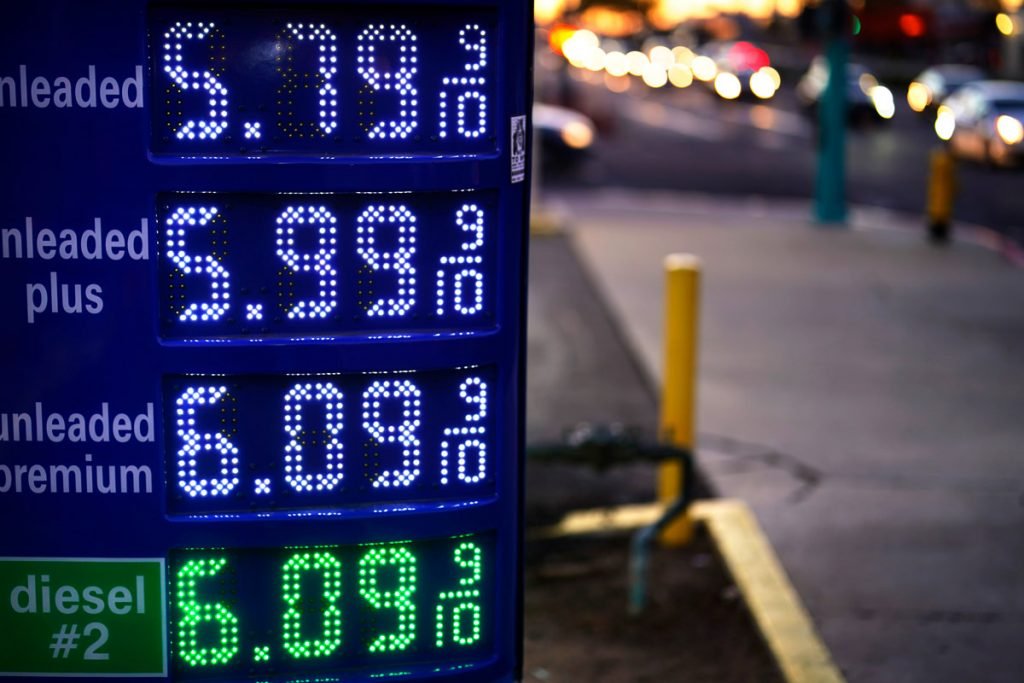Filling up the gas tank can be a thoroughly miserable experience as you watch the counter flip past $40, then $50, and keep on going.
But you can save money on gas based on where you fill up, how you pay, when you visit the gas station, how you drive and even the condition of your car.
We’ve compiled 20 smart tips to help you spend less on fuel.
How to Save on Gas at the Pump
The biggest savings will be evident in the price you pay at the gas station. So it’s worth shopping around and employing a bit of strategy before filling up.
1. Use Apps to Find the Cheapest Gas
You don’t want to buy gas at one place and then come across a station with cheaper fuel just down the street. Several websites and apps tell you the price of gasoline at the stations in your area. Upside, GasBuddy and Waze are popular options.
Look for the cheapest gas stations along any of the routes you normally drive for work or shopping. Don’t wait until your tank is near empty and be forced to buy gas wherever is closest.
The price of gas can vary significantly across state lines, so if you’re planning a trip, check where prices are lower throughout your route. Avoid getting gas at stations just off a highway exit or in the middle of a major city — stations in those locations tend to charge more than ones a little more out of the way.
2. Skip the Premium Option
Higher-octane gas isn’t necessary or beneficial in most cars, so you’re just spending more money when you buy premium. Premium gas can cost about 20 to 40 cents per gallon more than regular-grade fuel. Use regular-grade gasoline unless your car’s manufacturer specifically requires premium.
3. Join a Fuel Rewards Program
Many gas station chains and grocery stores across the country offer fuel rewards programs to try to turn you into a loyal customer. Each gas station fuel rewards program has its own set of rules on how much you can save and what you have to spend in order to get the rewards, so read up on the details.
GasBuddy also offers its own fuel savings program called Pay with GasBuddy. Join for free, and you’ll save up to 25 cents per gallon when you fill up at most national gas station chains. You can also sign up for a paid version. Pay with GasBuddy Premium is $9.99 a month and offers up to 40 cents off per gallon plus 24-hour roadside assistance.
(Note: Exxon Mobil, BJs, Costco, Sam’s Club, H-E-B, select Walmart stations, select Arco stations and some small, local gas stations don’t accept the Pay with GasBuddy card.)
4. Use a Rewards Credit Card
When you fuel up, choose a credit card that pays you cash back or one that allows you to earn rewards points when you purchase gas. Just be sure you know what you’re getting into before opening a rewards credit card. Pay the fuel charges off in full each month so you’re not paying interest on your gas purchases.

5. Use Cash Instead of a Card
Some gas stations charge a lower price per gallon if you pay with cash rather than a credit card. It’s their way of avoiding card processing fees. While some stations will let you pay the cash price if you use a debit card, others won’t. Check with the gas station before you swipe your card, or simply use cash when it’s time to fill up.
6. Use Free or Discounted Gift Cards
You can earn gift cards or cash from survey sites like MyPoints or CashKarma. You can also purchase discounted gift cards from sites like Raise or Gift Card Granny.
7. Fill Up Early in the Week
According to a 2019 GasBuddy gas price analysis, gas prices tend to be the lowest on Mondays and Tuesdays. If you’re looking to buy cheap gas, avoid filling your tank on Fridays, Saturdays or Sundays, when gas prices tend to be the most expensive.
How to Save on Gas With Better Driving Habits
How frequently you drive and how you operate your vehicle both play a role in how much you spend on gas.
8. Share Rides
If you live near your co-workers and have similar schedules, take turns driving so you can all drive less each week. Organize a carpool with neighbors or friends to transport your children to school or extracurricular activities, and swap driving duties among the parents.
9. Plan Routes
Plan your shopping trips and other outings in efficient ways to reduce your drive time. If the grocery store is near your job, do your shopping after work rather than waiting until the weekend. Do your errands all in one day rather than making several trips on different days. Cutting a few miles several times weekly could save a fill-up or two.
10. Reduce Your Idle Time
Don’t start the car and then leave it running for a long time while you wait for everyone to get in or to fiddle with your navigation. Make sure you’re ready to go before starting your engine. Idling just wastes gas and causes more air pollution.
11. Accelerate Slowly and Coast More
Be gradual when you’re speeding up or slowing down. Generally, the faster you accelerate, the more gas you use. Be gentle on that pedal when getting up to highway speed. You’ll also get better mileage by coasting more, so look ahead for stops and turns. Take your foot off the gas a bit sooner and slowly glide to a stop. This actually works.
12. Use Cruise Control — Sometimes
When it’s hilly, you might get better mileage without cruise control because the system will tend to downshift too much and waste gas. But otherwise, cruise! Staying at a steady speed with cruise control has been shown to save on fuel usage — plus you can make sure you don’t go over the speed limit.
13. Reduce the Use of Your Heater and Air Conditioning
Blasting the heat in the winter or the A/C in the summer has an effect on your fuel economy, so keep that in mind.
There’s a long-running but still inconclusive debate about whether using air conditioning or rolling down the windows contributes more to increased fuel consumption, since wind resistance from open windows creates drag on your vehicle.
When driving at low speeds you may want to cool down by lowering your car windows, but if you’re driving on the highway (or even driving above 30 miles per hour), you might be better off with the air conditioner on and the windows up.
14. Slow Down
Following the speed limit or driving just under it can pay off in more ways than you might think. The faster you drive, the more wind resistance you face, which reduces your fuel economy.
How Your Car Affects How Much You Spend on Gas
The condition of your car makes a difference in gas consumption. Learn how to keep your ride in money-saving shape.

15. Check Tire Pressure
Having underinflated tires can lower your gas mileage and cause you to lose about 3 cents per gallon, according to the U.S. Department of Energy. To find the proper tire pressure for your car, check your owner’s manual or the sticker in the driver’s side door jamb or in the glove box.
16. Check Your Gas Cap
A bad seal or missing cap can allow gas to evaporate from your tank. Besides costing you money, this pollutes the air. Replace your gas cap if the rubber seal seems worn or damaged.
17. Lighten Your Car
The less you have weighing down your vehicle, the better gas mileage it gets. Look at what you’ve got in your car and remove anything you don’t need. The neglected sports equipment in your trunk can go.
18. Remove Racks
If you don’t use that bicycle rack, remove it. Take off that ski rack while you’re at it. Racks are extra weight and create more wind resistance — both of which reduce gas mileage.
19. Use the Right Oil During Oil Changes
Using the wrong grade of motor oil can cost you 4 to 9 cents per gallon, according to the U.S. Department of Energy. Be sure to use your manufacturer’s recommended grade of oil, and look for motor oil designated as “energy conserving” or “energy saving.”
Synthetic motor oil (which may cost two or three times more than conventional motor oil) reduces friction better and improves your gas mileage, according to AutoGuide.
20. Buy a More Efficient Car
Making your next vehicle one that has a higher MPG (miles per gallon) rating is a sure-fire way to spend less on gasoline. Consider a hybrid car — or a used electric one, if you never want to worry about buying gas again.
A vehicle with a manual transmission tends to have better fuel efficiency than an automatic. Plus, driving a stick shift is cool.
Steve Gillman is a former contributor to The Penny Hoarder. Senior writer Nicole Dow contributed to this post.
Filling up the gas tank can be a thoroughly miserable experience as you watch the counter flip past $40, then $50, and keep on going.
But you can save money on gas based on where you fill up, how you pay, when you visit the gas station, how you drive and even the condition of your car.
We’ve compiled 20 smart tips to help you spend less on fuel.
The biggest savings will be evident in the price you pay at the gas station. So it’s worth shopping around and employing a bit of strategy before filling up.
You don’t want to buy gas at one place and then come across a station with cheaper fuel just down the street. Several websites and apps tell you the price of gasoline at the stations in your area. Upside, GasBuddy and Waze are popular options.
Look for the cheapest gas stations along any of the routes you normally drive for work or shopping. Don’t wait until your tank is near empty and be forced to buy gas wherever is closest.
The price of gas can vary significantly across state lines, so if you’re planning a trip, check where prices are lower throughout your route. Avoid getting gas at stations just off a highway exit or in the middle of a major city — stations in those locations tend to charge more than ones a little more out of the way.
Higher-octane gas isn’t necessary or beneficial in most cars, so you’re just spending more money when you buy premium. Premium gas can cost about 20 to 40 cents per gallon more than regular-grade fuel. Use regular-grade gasoline unless your car’s manufacturer specifically requires premium.
Many gas station chains and grocery stores across the country offer fuel rewards programs to try to turn you into a loyal customer. Each gas station fuel rewards program has its own set of rules on how much you can save and what you have to spend in order to get the rewards, so read up on the details.
GasBuddy also offers its own fuel savings program called Pay with GasBuddy. Join for free, and you’ll save up to 25 cents per gallon when you fill up at most national gas station chains. You can also sign up for a paid version. Pay with GasBuddy Premium is $9.99 a month and offers up to 40 cents off per gallon plus 24-hour roadside assistance.
(Note: Exxon Mobil, BJs, Costco, Sam’s Club, H-E-B, select Walmart stations, select Arco stations and some small, local gas stations don’t accept the Pay with GasBuddy card.)
When you fuel up, choose a credit card that pays you cash back or one that allows you to earn rewards points when you purchase gas. Just be sure you know what you’re getting into before opening a rewards credit card. Pay the fuel charges off in full each month so you’re not paying interest on your gas purchases.
Some gas stations charge a lower price per gallon if you pay with cash rather than a credit card. It’s their way of avoiding card processing fees. While some stations will let you pay the cash price if you use a debit card, others won’t. Check with the gas station before you swipe your card, or simply use cash when it’s time to fill up.
You can earn gift cards or cash from survey sites like MyPoints or CashKarma. You can also purchase discounted gift cards from sites like Raise or Gift Card Granny.
According to a 2019 GasBuddy gas price analysis, gas prices tend to be the lowest on Mondays and Tuesdays. If you’re looking to buy cheap gas, avoid filling your tank on Fridays, Saturdays or Sundays, when gas prices tend to be the most expensive.
How frequently you drive and how you operate your vehicle both play a role in how much you spend on gas.
If you live near your co-workers and have similar schedules, take turns driving so you can all drive less each week. Organize a carpool with neighbors or friends to transport your children to school or extracurricular activities, and swap driving duties among the parents.
Plan your shopping trips and other outings in efficient ways to reduce your drive time. If the grocery store is near your job, do your shopping after work rather than waiting until the weekend. Do your errands all in one day rather than making several trips on different days. Cutting a few miles several times weekly could save a fill-up or two.
Don’t start the car and then leave it running for a long time while you wait for everyone to get in or to fiddle with your navigation. Make sure you’re ready to go before starting your engine. Idling just wastes gas and causes more air pollution.
Be gradual when you’re speeding up or slowing down. Generally, the faster you accelerate, the more gas you use. Be gentle on that pedal when getting up to highway speed. You’ll also get better mileage by coasting more, so look ahead for stops and turns. Take your foot off the gas a bit sooner and slowly glide to a stop. This actually works.
When it’s hilly, you might get better mileage without cruise control because the system will tend to downshift too much and waste gas. But otherwise, cruise! Staying at a steady speed with cruise control has been shown to save on fuel usage — plus you can make sure you don’t go over the speed limit.
Blasting the heat in the winter or the A/C in the summer has an effect on your fuel economy, so keep that in mind.
There’s a long-running but still inconclusive debate about whether using air conditioning or rolling down the windows contributes more to increased fuel consumption, since wind resistance from open windows creates drag on your vehicle.
When driving at low speeds you may want to cool down by lowering your car windows, but if you’re driving on the highway (or even driving above 30 miles per hour), you might be better off with the air conditioner on and the windows up.
Following the speed limit or driving just under it can pay off in more ways than you might think. The faster you drive, the more wind resistance you face, which reduces your fuel economy.
The condition of your car makes a difference in gas consumption. Learn how to keep your ride in money-saving shape.
Having underinflated tires can lower your gas mileage and cause you to lose about 3 cents per gallon, according to the U.S. Department of Energy. To find the proper tire pressure for your car, check your owner’s manual or the sticker in the driver’s side door jamb or in the glove box.
A bad seal or missing cap can allow gas to evaporate from your tank. Besides costing you money, this pollutes the air. Replace your gas cap if the rubber seal seems worn or damaged.
The less you have weighing down your vehicle, the better gas mileage it gets. Look at what you’ve got in your car and remove anything you don’t need. The neglected sports equipment in your trunk can go.
If you don’t use that bicycle rack, remove it. Take off that ski rack while you’re at it. Racks are extra weight and create more wind resistance — both of which reduce gas mileage.
Using the wrong grade of motor oil can cost you 4 to 9 cents per gallon, according to the U.S. Department of Energy. Be sure to use your manufacturer’s recommended grade of oil, and look for motor oil designated as “energy conserving” or “energy saving.”
Synthetic motor oil (which may cost two or three times more than conventional motor oil) reduces friction better and improves your gas mileage, according to AutoGuide.
Making your next vehicle one that has a higher MPG (miles per gallon) rating is a sure-fire way to spend less on gasoline. Consider a hybrid car — or a used electric one, if you never want to worry about buying gas again.
A vehicle with a manual transmission tends to have better fuel efficiency than an automatic. Plus, driving a stick shift is cool.
Steve Gillman is a former contributor to The Penny Hoarder. Senior writer Nicole Dow contributed to this post.
Ready to stop worrying about money?
Get the Penny Hoarder Daily
Privacy Policy
© 2022 The Penny Hoarder. – All rights reserved.
Privacy Policy and Terms of Service | Do Not Sell My Personal Information | Cookies Settings






